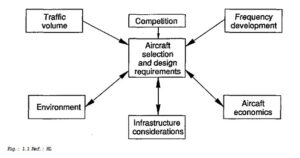The forecast traffic growth rate of about 5.4% per annum world wide, leads to roughly 3 times as many passengers (2.8 billion) per year by the end of 2009.
This average growth, however, will be subject to large variations in aircraft business.
Growing congestion on the ground and in the air will lead to an acceleration in demand for wide body aircraft to absorb the predicted traffic volume. At several key airports the provision of more flight frequencies seems almost impossible in the medium term.
Added to these growth and congestion effects the identifiable need to replace current large aircraft leads, early in the next century, to a requirement for an Ultra High Capacity Aircraft (UHCA).
This diploma thesis will investigate the need, propose a design and examine the effects on the environment and airport infrastructure of a UHCA.
The main points to look at are:

Traffic volume, competition and frequency development are prime criteria affecting the number and size of the UHCA.
Aircraft selection and design requirements, including the draft of a UHCA design of a selected size, are spotting the main data of the aircraft and its performance.
Environmental acceptance, aircraft economics and infrastructure considerations are further important criteria related to the design targets.
The technical part of the thesis was prepared with the help of the Bureau for Future Projects at Deutsche Airbus, in Hamburg.
The Marketing part was written with the help and prestudies of the Marketing Planning Department at Airbus Industrie, in Toulouse.